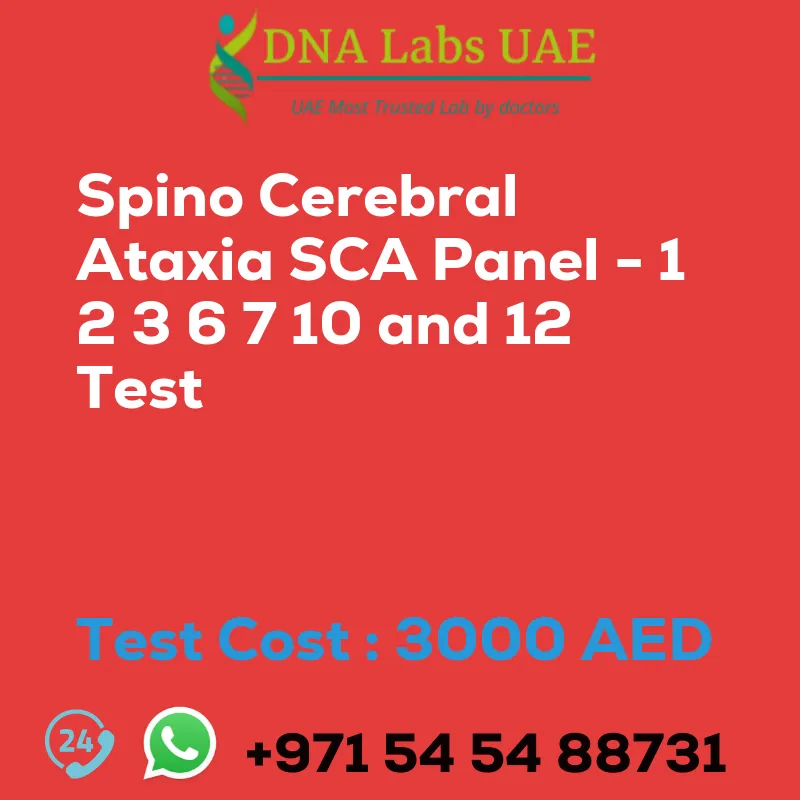Spino Cerebral Ataxia SCA Panel – 1 2 3 6 7 10 and 12 Test
Test Name: Spino Cerebral Ataxia SCA Panel – 1 2 3 6 7 10 and 12 Test
Components: EDTA Vacutainer (2ml)
Price: 3000.0 AED
Sample Condition: Peripheral blood
Report Delivery: 5-7 days
Method: End Point PCR
Test Type: Genetics
Doctor: General Physician
Test Department:
Pre Test Information: Spino Cerebral Ataxia (SCA Panel – 1, 2, 3, 6, 7, 10 & 12) can be done with a Doctors prescription. Prescription is not applicable for surgery and pregnancy cases or people planning to travel abroad.
Test Details:
Spino Cerebral Ataxia (SCA) is a group of genetic disorders that affect the nervous system and primarily cause problems with movement coordination. There are several types of SCA, each caused by mutations in different genes.
The SCA panel, also known as the SCA genetic test, is a diagnostic tool that analyzes specific genes associated with various types of SCA. The panel typically includes testing for genes SCA1, SCA2, SCA3, SCA6, SCA7, SCA10, and SCA12. These genes are known to be involved in the development of different forms of SCA.
By analyzing the DNA of an individual, the SCA panel can detect mutations or abnormalities in these genes, which can help in diagnosing the specific type of SCA a person may have. It can also provide information about the risk of passing on the condition to future generations.
The SCA panel is usually performed on individuals who have symptoms of ataxia, such as uncoordinated movements, balance problems, and difficulty with speech or swallowing. It can also be used for genetic counseling and family planning purposes.
It is important to note that the SCA panel only tests for specific genes associated with SCA and does not cover all possible genetic causes of ataxia. In some cases, additional genetic testing may be necessary to rule out other potential causes.
Overall, the SCA panel is a valuable tool in diagnosing and managing SCA, as it provides important genetic information that can guide treatment decisions and help individuals and their families understand the condition better.
| Test Name | Spino Cerebral Ataxia SCA Panel – 1 2 3 6 7 10 and 12 Test |
|---|---|
| Components | EDTA Vacutainer (2ml) |
| Price | 3000.0 AED |
| Sample Condition | Peripheral blood |
| Report Delivery | 5-7 days |
| Method | End Point PCR |
| Test type | Genetics |
| Doctor | General Physician |
| Test Department: | |
| Pre Test Information | Spino Cerebral Ataxia (SCA Panel – 1, 2, 3, 6, 7, 10 & 12) can be done with a Doctors prescription. Prescription is not applicable for surgery and pregnancy cases or people planing to travel abroad. |
| Test Details |
Spino Cerebral Ataxia (SCA) is a group of genetic disorders that affect the nervous system and primarily cause problems with movement coordination. There are several types of SCA, each caused by mutations in different genes. The SCA panel, also known as the SCA genetic test, is a diagnostic tool that analyzes specific genes associated with various types of SCA. The panel typically includes testing for genes SCA1, SCA2, SCA3, SCA6, SCA7, SCA10, and SCA12. These genes are known to be involved in the development of different forms of SCA. By analyzing the DNA of an individual, the SCA panel can detect mutations or abnormalities in these genes, which can help in diagnosing the specific type of SCA a person may have. It can also provide information about the risk of passing on the condition to future generations. The SCA panel is usually performed on individuals who have symptoms of ataxia, such as uncoordinated movements, balance problems, and difficulty with speech or swallowing. It can also be used for genetic counseling and family planning purposes. It is important to note that the SCA panel only tests for specific genes associated with SCA and does not cover all possible genetic causes of ataxia. In some cases, additional genetic testing may be necessary to rule out other potential causes. Overall, the SCA panel is a valuable tool in diagnosing and managing SCA, as it provides important genetic information that can guide treatment decisions and help individuals and their families understand the condition better. |








